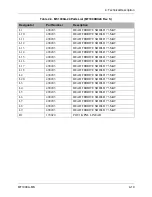
MT1099A-MS
4-1
CHAPTER 4
TECHNICAL DESCRIPTION
4.1
Circuit Description
The MT-1099A mobile mount is available in two configurations according to
source voltages: +12 Vdc and +24 Vdc.
4.1.1
MT-1099A-12
The MT-1099A-12 receives input power (12 Vdc) through rear panel connector
J5 and routes it directly to the rear panel J4 connector to power the RA100-12
RF power amplifier for 100W applications. The MT-1099A also routes the
input voltage to the internal amplifier board where it passes through an LC
π
filter consisting of C1, C2 and L1. Then the 12V line goes to the center pole on
the front panel power switch S1A. From the power switch, the input voltage
goes to internal connector J6. A jumper bridges J6 pin 1 to J6 pin 3. From J6 pin
3, the 12V line goes through another LC filter consisting of L2, C10 and
transient voltage suppression diode D3 on the amplifier board, then it goes to
the front panel TRANSCEIVER connector J1 to the PRC1099/A ACCESSORY
connector, the AMP CONTROL connector J2 and to the TUNER CONTROL
connector J3.
The MT-1099A provides a built-in external waterproof speaker for audio
received from the PRC1099/A through the front panel MT-1099A J1 connector.
The audio goes to the amplifier board which amplifies the audio using op amp
LM386 U1, then it routes the audio to the built-in external speaker. A front
panel VOLUME switch controls the speaker volume.
The PTT signal from the transceiver comes in through the front panel J1
connector, then goes to the amplifier board where it activates a switching relay
that shuts off the audio to the external speaker when an operator presses the
PTT button on the handset.
The MT-1099A includes a microcontroller that passes RS-232 serial
information between the PR1099A and the RA100 and RA400-99 RF power
amplifiers (clock and band selection data), and RAT1000C (channel data and
clock) or RAT7000B (channel data, clock and strobe) antenna tuners.
















































